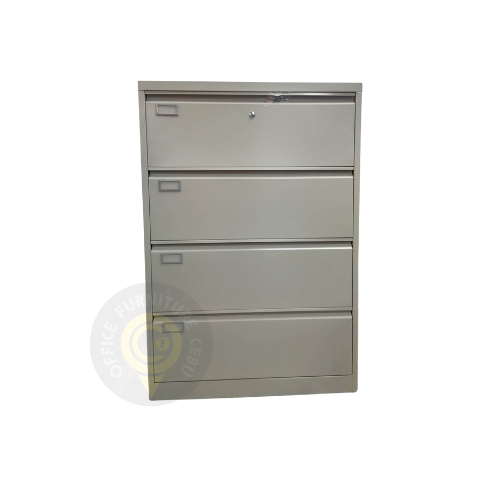Lateral File Cabinet Cebu
The most basic definition of a Lateral File Cabinet Cebu is just an enclosure for drawers that hold goods. A filing cabinet is used to store paper documents in file folders, usually vertical or lateral. Drawers of a vertical file cabinet extend from the short side, which is normally 15 inches (380 mm) long. The long side of a lateral file cabinet contains drawers that extend from it in varying lengths. In Britain, these are also as side filers. Additionally, there are shelf files that are place on shelves.
Office file cabinets are usually made of wood or sheet metal, with drawer slides and thumblatches. There is a handle on each drawer that may be use to pull it out. Each drawer often has a label holder on the front face to help the user determine what is within.
To guard against unwant access to the papers being house, many file cabinets have a keyed lock. Two different kinds of locks exist. A “cam lock” is open by turning the lock with a key. A “plunger lock” is one that can be open with a key but closed by simply depressing the lock’s body. A user may swiftly close and lock numerous cabinets at once with the plunger lock.
A follower block is a metal plate or wire structure used to keep file folders upright and at the front of a filing cabinet.
A standard lateral file
measures 20 inches (510 mm) deep, comes in 2, 3, 4, and 5 drawer models, and has a width of 30, 36, and 42 inches (760, 910, and 1,070 mm). The 30-inch (760 mm) wide, two-drawer model is frequently use within cubicle workstations since it is designed to fit beneath or next to the cubicle work surfaces. Similar reasoning applies to the usage of 3-, 4-, and 5-drawer filing systems. Most lateral files, unlike vertical ones, support filing from the front to the rear or from side to side.
30- and 42-inch-wide files are the most efficient for letter-size files stacked front to back, providing the most filing space per cabinet. 36-inch (910 mm) files have no more capacity than 30-inch (760 mm) files.
Some people prefer side-to-side filing because it allows them to sit down while looking through the index tabs. This setup is compatible with all-width lateral files, however the file’s capacity is somewhat reduce.
Five-drawer lateral files typically have a flipper door and pull-out shelf to make accessing files easier.
Benefits of a filing cabinet
Filing cabinets are essential for managing large volumes of paperwork and files.
File cabinets are the most reliable way to store important papers documents.
Cabinet saves time and energy during work by offering files and papers stored in designated place.
The file cabinet is a useful tool for any office as it cluttered your desk & other place.
Filing cabinets reduce the chance to loss of company information and papers.
A lateral file cabinet
is more adaptable and able to store more papers. Overall, lateral files are a fantastic and effective method to keep your workplace (big or little) neat and organized. Lateral files are typically 20″ deep and 30″-42″ wide, with 2-3 drawers.
VERTICAL VS. LATERAL FILE
Therefore, why would anyone ever consider a vertical file if Lateral File Cabinet Cebu are so great? How can you tell if a vertical file or lateral file is better for you? Everything depends on your demands and the paperwork you need to file.
As previously noted, whether you are managing a practice or a business, you will have a number of files that you need to access often. If so, a lateral file is most likely the best option. However, a vertical file cabinet is the best option if you require a file for personal use or need to keep papers that you must have but seldom need to refer to (tax documents and other personal information).
Vertical file cabinets
are ideal for usage in homes with limited space since they take up less floor area. They are substantially lighter and thinner than lateral files, making them simpler to transfer if necessary.
Additionally, there are mobile files, which are almost always vertical files and include casters that make it really simple to move the file anywhere you need it. Moving lateral files is substantially more challenging and uncomfortable.
The tops of these mobile and vertical files can nevertheless accommodate your printer even if they aren’t as roomy as lateral files. You could even more room by doing this.
A vertical file cabinet is an acceptable alternative if keeping a lot of data and having rapid access are not your top priorities. It is easy to locate in sizes that fit beneath your desk.

